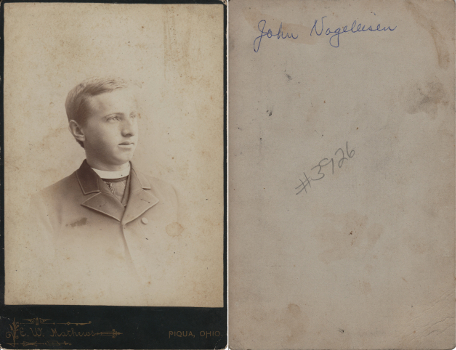
STATUS: REUNITED WITH FAMILY
PHOTOGRAPH INFORMATION
NAME(S):
John
Nageleisen
PHOTOGRAPH:
#
3926
OTHER
INFO: None
PHOTOGRAPHER:
E.
W.
Mathews, Piqua, Ohio
CARD
SIZE: 10.7
cm
x 16.4 cm
WHERE
PURCHASED: Bradenton,
Florida
WHEN
PURCHASED: February
18,
2017
RESEARCHED INFORMATION
Probably: Rev. John August Nageleisen
Born:
August 27, 1861, Piqua, Miami County, Ohio
Died: May
6, 1952, New York
Father: Wilibald Fidelis
Nageleis
Mother: Rosa Schuler
Married:
Children:
NOTES
“Charity for the Suffering Souls”, by John A. Nageleisen"
Predestination:
The
American Career of a Contentious Doctrine by Peter
J.
Thuesen
"Far more compelling to Catholic apologists . . . was the argument that thepious devotions of the communion of saints not only helped the dead
but brought hope and comfort to the living. A leading U.S. spokesman for this idea was Monsignor John A. Nageleisen, who was bornto a German
Daytonian
in
Manhattan, Tuesday, January 12, 2016
(The stories behind the
buildings, statues and other points of interest that
make Manhattan
fascinating.)
The
1903
St. Nicholas Rectory -- No. 135 East 2nd Street
"In the meantime, Father John A. Nageleisen was dealing with bad press.Five years after the rectory was built, he had arrived from Cincinnati, Ohio to
become pastor. By the time the day school was installed in the rectory, the sometimes controversial priest had become highly unpopular with residentsSOURCES
1870
Census
Piqua Ward 3, Miami County, Ohio
1880 Census Piqua, Miami
County, Ohio
1915 State Census New York City, New York County,
New York
1920 Census Manhattan Ward 17, New York County, New
York
1930 Census Manhattan, New York County, New York
1940
Census Manhattan, New York County, New York
Ontario, Canada, The
Ottawa Journal
FindAGrave.com
Nagelsen_CZ
Family Tree on Ancestry.com